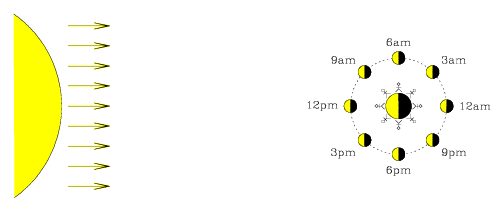We are looking down on the solar system, from above the North Pole. The Earth
rotates on its own axis counterclockwise once a day (you can verify this by
checking that the Sun will appear to rise in the east at dawn and set in the
west at dusk), and the Moon orbits counterclockwise around the Earth once a
month.
The Moon has been drawn in its eight major phases. In each case, a figure
( )
placed below the Moon on the surface of the
Earth shows where one would stand to see the Moon directly overhead, and the
time of day or night is identified. You can imagine that the Earth is the
center of a gigantic clock, and as you stand on it you sweep through 24 (not
12!) hours with every full circle, forming our night and day cycle.
)
placed below the Moon on the surface of the
Earth shows where one would stand to see the Moon directly overhead, and the
time of day or night is identified. You can imagine that the Earth is the
center of a gigantic clock, and as you stand on it you sweep through 24 (not
12!) hours with every full circle, forming our night and day cycle.

The Moon is always half illuminated (the side facing the Sun), and half in
shadow (the side hidden from the Sun). Where must the Moon be (relative to
the Earth) so that we see the fraction of the illuminated side corresponding
to the correct lunar phase? What time is it if you are on the side of the
Earth directly underneath this point?
The following table lists the eight major phases of the Moon, which can be
observed over a period of 29.5 days. It shows the
appearance of the Moon from Earth, and the time of night or day at which the
Moon will be directly overhead for each phase. Test your understanding by
looking at each phase, and comparing the appearance of the Moon in the table
with the fraction of the Moon which is illuminated which can be seen from
Earth (as deduced from the above figure).
| Lunar Phase | Full |
Waning gibbous |
Third quarter |
Waning crescent |
New |
Waxing crescent |
First quarter |
Waxing gibbous |
|---|
| Appearance |  |
 |
 |
 |
 |
 |
 |
 |
|---|
| Overhead @ | 12 am |
3 am |
6 am |
9 am |
12 pm |
3 pm |
6 pm |
9 pm |
|---|
You may assume that it is noon when the Sun is directly overhead in the sky, 6
pm at sunset, midnight when the Sun is most hidden behind the Earth, and 6 am
at sunrise. (Don't worry about daylight savings time, and remember that 12 pm
is noon, and 12 am is midnight.)
[NMSU, N. Vogt]
 )
placed below the Moon on the surface of the
Earth shows where one would stand to see the Moon directly overhead, and the
time of day or night is identified. You can imagine that the Earth is the
center of a gigantic clock, and as you stand on it you sweep through 24 (not
12!) hours with every full circle, forming our night and day cycle.
)
placed below the Moon on the surface of the
Earth shows where one would stand to see the Moon directly overhead, and the
time of day or night is identified. You can imagine that the Earth is the
center of a gigantic clock, and as you stand on it you sweep through 24 (not
12!) hours with every full circle, forming our night and day cycle.








